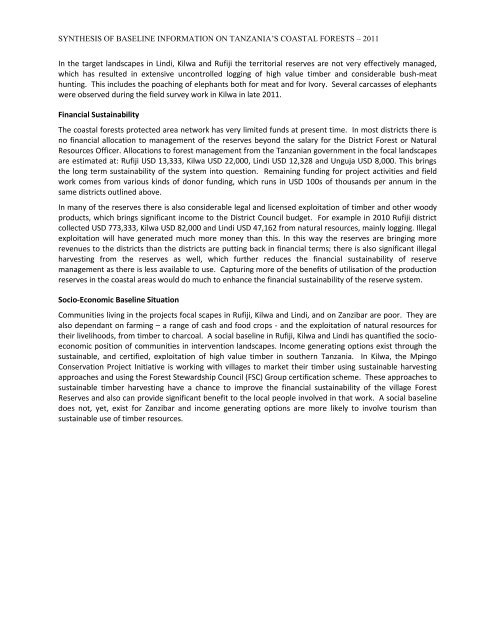Neil D. Burgess, Paul Harrison, Peter Sumbi, James Laizer, Adam ...
Neil D. Burgess, Paul Harrison, Peter Sumbi, James Laizer, Adam ...
Neil D. Burgess, Paul Harrison, Peter Sumbi, James Laizer, Adam ...
Create successful ePaper yourself
Turn your PDF publications into a flip-book with our unique Google optimized e-Paper software.
SYNTHESIS OF BASELINE INFORMATION ON TANZANIA’S COASTAL FORESTS – 2011<br />
In the target landscapes in Lindi, Kilwa and Rufiji the territorial reserves are not very effectively managed,<br />
which has resulted in extensive uncontrolled logging of high value timber and considerable bush-meat<br />
hunting. This includes the poaching of elephants both for meat and for Ivory. Several carcasses of elephants<br />
were observed during the field survey work in Kilwa in late 2011.<br />
Financial Sustainability<br />
The coastal forests protected area network has very limited funds at present time. In most districts there is<br />
no financial allocation to management of the reserves beyond the salary for the District Forest or Natural<br />
Resources Officer. Allocations to forest management from the Tanzanian government in the focal landscapes<br />
are estimated at: Rufiji USD 13,333, Kilwa USD 22,000, Lindi USD 12,328 and Unguja USD 8,000. This brings<br />
the long term sustainability of the system into question. Remaining funding for project activities and field<br />
work comes from various kinds of donor funding, which runs in USD 100s of thousands per annum in the<br />
same districts outlined above.<br />
In many of the reserves there is also considerable legal and licensed exploitation of timber and other woody<br />
products, which brings significant income to the District Council budget. For example in 2010 Rufiji district<br />
collected USD 773,333, Kilwa USD 82,000 and Lindi USD 47,162 from natural resources, mainly logging. Illegal<br />
exploitation will have generated much more money than this. In this way the reserves are bringing more<br />
revenues to the districts than the districts are putting back in financial terms; there is also significant illegal<br />
harvesting from the reserves as well, which further reduces the financial sustainability of reserve<br />
management as there is less available to use. Capturing more of the benefits of utilisation of the production<br />
reserves in the coastal areas would do much to enhance the financial sustainability of the reserve system.<br />
Socio-Economic Baseline Situation<br />
Communities living in the projects focal scapes in Rufiji, Kilwa and Lindi, and on Zanzibar are poor. They are<br />
also dependant on farming – a range of cash and food crops - and the exploitation of natural resources for<br />
their livelihoods, from timber to charcoal. A social baseline in Rufiji, Kilwa and Lindi has quantified the socioeconomic<br />
position of communities in intervention landscapes. Income generating options exist through the<br />
sustainable, and certified, exploitation of high value timber in southern Tanzania. In Kilwa, the Mpingo<br />
Conservation Project Initiative is working with villages to market their timber using sustainable harvesting<br />
approaches and using the Forest Stewardship Council (FSC) Group certification scheme. These approaches to<br />
sustainable timber harvesting have a chance to improve the financial sustainability of the village Forest<br />
Reserves and also can provide significant benefit to the local people involved in that work. A social baseline<br />
does not, yet, exist for Zanzibar and income generating options are more likely to involve tourism than<br />
sustainable use of timber resources.

















